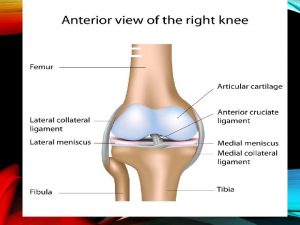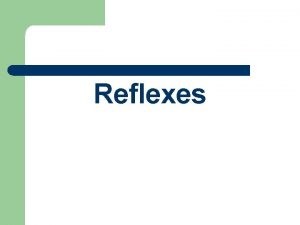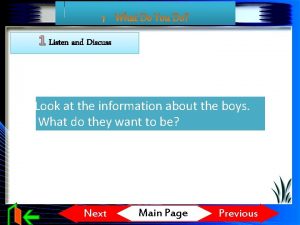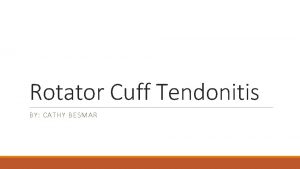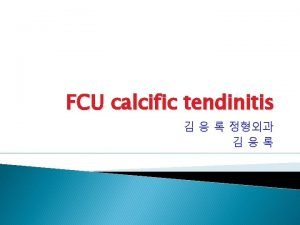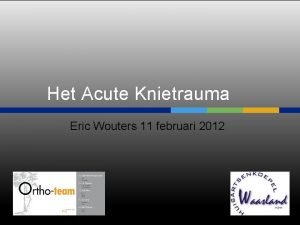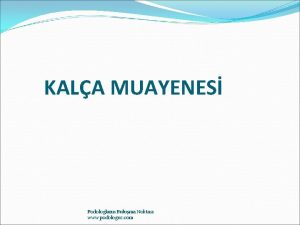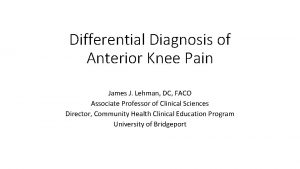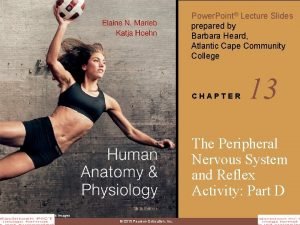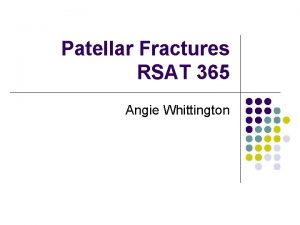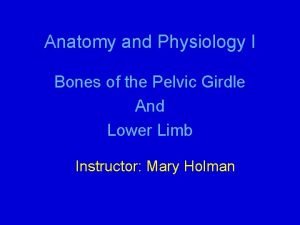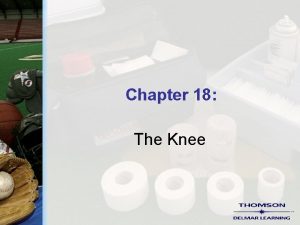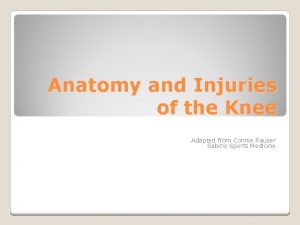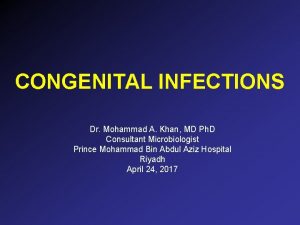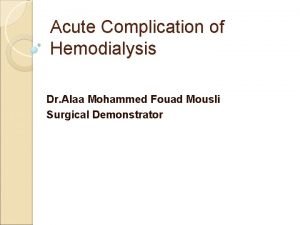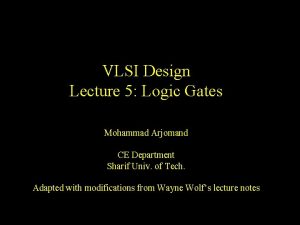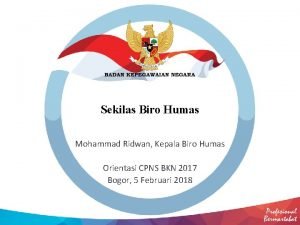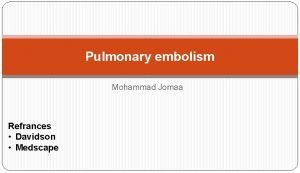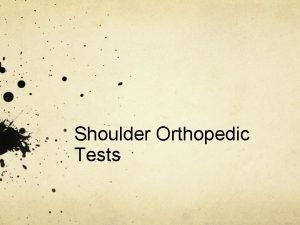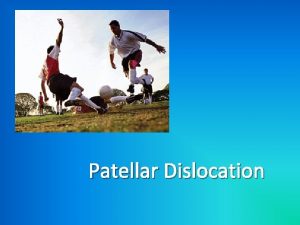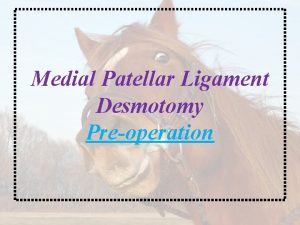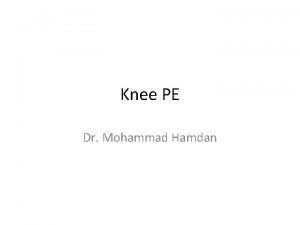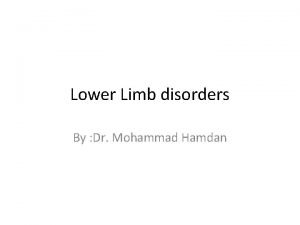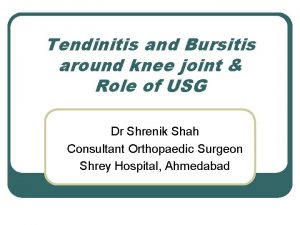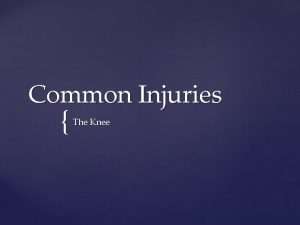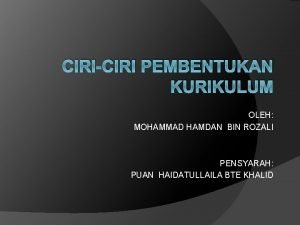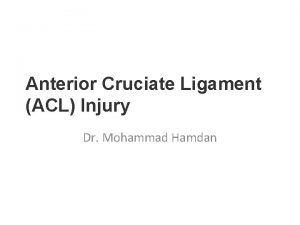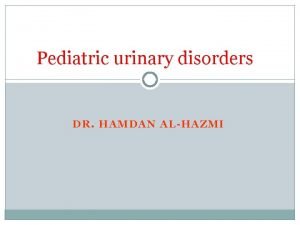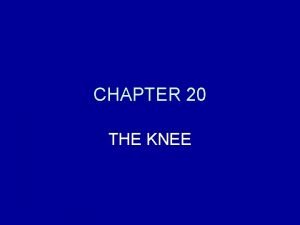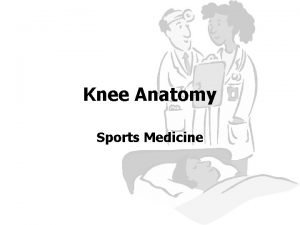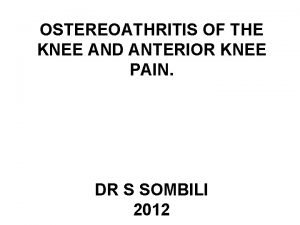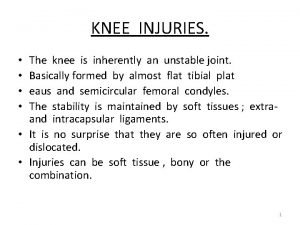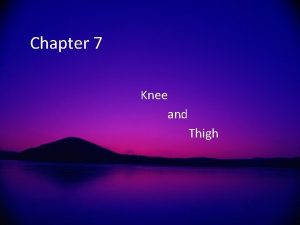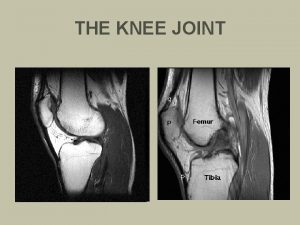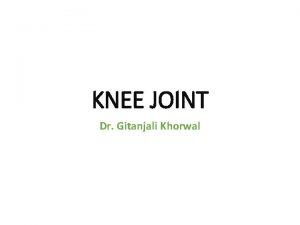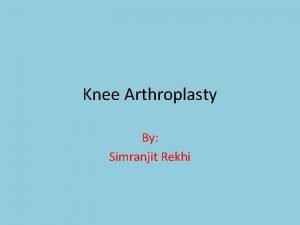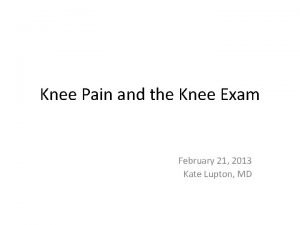Knee Disorders Dr Mohammad Hamdan Patellar Tendinitis Definition




































- Slides: 36

Knee Disorders Dr. Mohammad Hamdan

Patellar Tendinitis • Definition • • • activity-related anterior knee pain associated with focal patellar-tendon tenderness also known as "jumper's knee" Epidemiology • incidence • up to 20% of jumping athletes • demographics / risk factors • males > females • volleyball most common • more common in adolescents/young adults • quadriceps tendinopathy is more common in older adults • poor quadriceps and hamstring flexibility • Pathophysiology • mechanism • repetitive, forceful, eccentric contraction of the extensor mechanism • histology • degenerative, rather than inflammatory • micro-tears of the tendinous tissue are commonly seen

Presentation • Symptoms • insidious onset of anterior knee pain at inferior border of patella • initial phase • pain following activity • late phase • pain during activity • pain with prolonged flexion ("movie theater sign") • Physical exam • inspection • may have swelling over tendon • palpation • tenderness at inferior border of patella • provocative tests • Basset's sign • tenderness to palpation at distal pole of patella in full extension • no tenderness to palpation at distal pole of patella in full flexion

Imaging • Radiographs • recommended views • AP, lateral, skyline views of knee • findings • usually normal • may show inferior traction spur (enthesophyte) in chronic cases • Ultrasound • findings • thickening of tendon • hypoechoic areas • MRI • indications • chronic cases • surgical planning • findings • tendon thickening • more diagnostic than presence of edema • increased signal intensity on both T 1 and T 2 images • loss of the posterior border of fat pad in chronic cases

Treatment • Nonoperative • ice, rest, activity modification, followed by physical therapy • indications • most cases • technique • physical therapy • stretching of quadriceps and hamstrings • eccentric exercise program • ultrasound treatment may be helpful • taping or Chopat's strap can be used to reduce tension across patellar tendon • cortisone injections • are contraindicated due to risk of patellar tendon rupture • Operative • surgical excision and suture repair as needed

Quadriceps Tendonitis • Inflammation of the suprapatellar tendon of the quadriceps muscle • Epidemiology • demographics • 8: 1 male-to-female ratio • more common in adult athletes • risk factors • jumping sports • basketball • volleyball • athletics (e. g. , long jump, high jump, etc

Presentation • History • • Symptoms • • overuse injury in a jumping athlete recent increase in athletic demands or activity often a recurring injury pain localized to the superior border of patella worse with activity associated swelling Physical examination • inspection • knee alignment • swelling • palpation • tenderness to deep palpation at quadriceps tendon insertion at the patella • palpable gap would suggest a quads tendon tear • patellar subluxation • motion • pain with resisted open chain knee extension • able to actively extend the knee against gravity

Imaging • Radiographs • • recommended views • AP and lateral of knee optional views • Sunrise or Merchant views for patella instability findings • usually normal • may see tendon calcinosis in chronic degeneration measurement • evaluate knee alignment for varus/valgus angle • evaluate for patellar height (patella alta vs baja) for suspected quadriceps tendon rupture • • • Ultrasound • • • Blumentsaat's line should extend to inferior pole of the patella at 30 degrees of knee flexion Insall-Salvati method • normal between 0. 8 and 1. 2 indications • suspected acute or chronic findings • effective at detecting and localizing disruption in tendon • operator and user-dependent MRI • • indications • most sensitive imaging modality findings • intrasubstance signal and thickening of tendon

Treatment • Nonoperative • activity modification, NSAIDS, and physical therapy • indications • mainstay of treatment • technique • rest until pain is improved • physical therapy starting with range of motion and progressing to eccentric exercises • cortisone injections contraindicated due to risk of quadriceps tendon rupture • Operative • quadriceps tendon debridement • indications • very rarely required

Patellar Instability • Can be classified into the followingacute traumatic • occurs equally by gender • may occur from a direct blow (ex. helmet to knee collision in football) • chronic patholaxity • recurrent subluxation episodes • occurs more in women • associated with malalignment • habitual • usually painless • occurs during each flexion movement • pathology is usually proximal (e. g. tight lateral structures - ITB and vastus lateralis)

Presentation • Symptoms • • • complaints of instability anterior knee pain Physical exam • acute dislocation usually associated with a large hemarthrosis • absence of swelling supports ligamentous laxity and habitual dislocation mechanism • • medial sided tenderness (over MPFL) increase in passive patellar translation • measured in quadrants of translation (midline of patella is considered "0"), and also should be compared to contralateral side • normal motion is <2 quadrants of patellar translation • • lateral translation of medial border of patella to lateral edge of trochlear groove is considered "2" quadrants and is considered abnormal amount of translation patellar apprehension • passive lateral translation results in guarding and a sense of apprehension • • increased Q angle J sign • excessive lateral translation in extension which "pops" into groove as the patella engages the trochlea early in flexion • associated with patella alta

Imaging • Radiographs: • rule out fracture or loose body • medial patellar facet (most common) • lateral femoral condyle • MRI help further rule out suspected loose bodies • • osteochondral lesion and/or bone bruising medial patellar facet (most common) lateral femoral condyle tear of MPFL • tear usually at medial femoral epicondyle

Treatment

Nonoperative • NSAIDS, activity modification, and physical therapy • indications • mainstay of treatment for first time patellar dislocator • without any loose bodies or intraarticular damage • habitual dislocator

Operative • Arthroscopic debridement (removal of loose body) vs Repair with or without stabilization • indications • displaced osteochondral fractures or loose bodies • may be an indication for operative treatment in a first-time dislocator • MPFL repair • indications • acute first time dislocation with bony fragment • MPFL reconstruction with autograft vs allograft • indications • recurrent instability • no significant underlying malalignment • Fulkerson-type osteotomy (anterior and medial tibial tubercle transfer) • tibial tubercle distalization • lateral release

Lateral Patellar Compression Syndrome • Improper tracking of patella in trochlear groove • Caused by tight lateral retinaculum • leads to excessive lateral tilt without excessive patellar mobility • Miserable Triad • is a term coined for anatomic characteristics that lead to an increased Q angle and an exacerbation of patellofemoral dysplasia. They include: • femoral anteversion • genu valgum • external tibial torsion / pronated feet

Presentation • pain with stair climbing • theatre sign (pain with sitting for long periods of time) • Physical exam • pain with compression of patella and moderate lateral facet tenderness • inability to evert the lateral edge of the patella

Imaging • Radiographs • patellar tilt in lateral direction

Treatment • Nonoperative • NSAIDS, activity modification, and therapy • indications • mainstay of treatment and should be done for extensive period of time • technique • therapy should emphasize vastus medialis strengthening and closed chain short arc quadriceps exercises • Operative

Idiopathic Chondromalacia Patellae • Condition characterized by idiopathic articular changes of the patella • term is now falling out of favor • more commonly grouped together with a number of pathological entities known as • "anterior knee pain" or • "patellofemoral syndrome"

Presentation • Symptoms • • • diffuse pain in the peripatellar or retropatellar area of the knee (major symptom) insidious onset and typically vague in nature aggravated by specific daily activities including • climbing or descending stairs • prolonged sitting with knee bent (known as theatre pain) • squatting or kneeling • • always consider the physical, mental and social elements of knee pain Physical exam • • quadricep muscle atrophy signs of patella maltracking • increased femoral anteversion or tibial external rotation • lateral subluxation of patella or loss of medial patellar mobility • positive patellar apprehension test • • palpable crepitus pain with compression of patella with knee range of motion or resisted knee extension

Imaging • Radiographs • recommended views • AP, lateral and notch radiographs of knee • findings • may see chondrosis on xray • shallow sulcus, patella alta/baja, or lateral patella tilt • CT scan • indications • patellofemoral alignment • fracture • findings • trochlear geometry • TT-TG distance • torsion of the limb • MRI • indications • best modality to assess articular cartilage • views • T 2 best sequence to assess cartilage • abnormal cartilage is usually of high signal compared to normal cartilage

Treatment • Nonoperative • rest, rehab, and NSAIDS • indications • mainstay of treatment and should be done for a minimum of one year • technique • NSAIDS are more effective than steroids • activity modification • rehabilitation with emphasis on • vastus medialis obiquus strengthening • core strengthening • closed chain short arc quadriceps exercises • strengthening of hip external rotators • Operative

Quadriceps Tendon Rupture • • • Rupture of the quadriceps tendon leading to disruption in the extensor mechanism Epidemiology incidence • • demographics • • usually occurs in patients > 40 years of age males > females (up to 8: 1) occurs in nondominant limb more than twice as often location of rupture • • quadriceps tendon rupture is more common than patellar tendon rupture usually at insertion of tendon to the patella risk factors • • renal failure diabetes rheumatoid arthritis hyperparathyroidism connective tissue disorders steroid use intraarticular injections (in 20 -33%)

Presentation • History • often report a history of pain leading up to rupture consistent with an underlying tendonopathy • Symptoms • pain • Physical exam • tenderness at site of rupture • palpable defect usually within 2 cm of superior pole of patella • unable to extend the knee against resistance • unable to perform straight leg raise with complete rupture

Imaging • Radiographs • recommended views • AP and lateral of knee • findings • will show patella baja • MRI • indications • when there is uncertainty regarding diagnosis • helps differentiate between a partial and complete tear

Treatment • Nonoperative • knee immobilization in brace • indications • partial tear with intact knee extensor mechanism • patients who cannot tolerate surgery • Operative • primary repair with reattachment to patella • indications • complete rupture with loss of extensor mechanism

Patella Tendon Rupture • • Disruption of the tendon attaching the patella to the tibial tubercle (the patella is a sesamoid bone making this a tendon, not a ligament) Epidemiology • incidence • • demographic • • • most commonly in 3 rd and 4 th decade male > female location • • < 0. 5% of the US population per year quadriceps tendon rupture > patella tendon rupture risk factors • weakening of collagen structure • • • systemic • systemic lupus erythematous • rheumatoid arthritis • chronic renal disease • diabetes mellitus local • patellar degeneration (most common) • previous injury • patellar tendinopathy other • corticosteroid injection

Presentation • History • • Symptoms • • sudden quadriceps contraction with knee in a flexed position (e. g. , jumping sports, missing step on stairs) infrapatellar pain popping sensation difficulty weight-bearing Physical exam • inspection • • • elevation of patella height usually associated with a large hemarthrosis and ecchymosis localized tenderness palpable gap below the inferior pole of the patella motion • unable to perform active straight leg raise or maintain passively extended knee • reduced ROM of knee (and difficulty bearing weight) due to pain • if only tendon is ruptured and retinaculum is intact, active extension will be possible but will have extensor lag of a few degrees

Imaging • Radiographs • recommended views • • optional views • • patella alta seen in complete rupture knee in flexion (ideally 30 degrees), the Insall-Salvati ratio is > 1. 2 Ultrasound • indications • • suspected acute and chronic injuries findings • • • merchant or skyline findings • • • AP and lateral of the knee effective at detecting and localizing disruption operator and user-dependent MRI • indications • • • differentiate partial from complete tendon rupture most sensitive imaging modality findings • site of disruption, tendon degeneration, patellar position, and associated soft tissue injuries

Treatment • Nonoperative • immobilization in full extension with a progressive weight-bearing exercise program • indications • partial tears with intact extensor mechanism • modalities • • • application of a removable knee splint early knee range of motion Operative • primary repair • indications • • complete patellar tendon ruptures ability to approximate tendon at site of disruption • techniques • • end-to-end repair transosseous tendon repair suture anchor tendon repair tendon reconstruction • indications • severely disrupted or degenerative patella tendon • techniques • semitendinosus or gracilis tendon autograft

Articular Cartilage Defects of Knee • Spectrum of disease entities from single, focal defects to advanced degenerative disease of articular (hyaline) cartilage

Presentation • History • commonly present with history of precipitating trauma • some defects found incidentally on MRI or arthroscopy • Symptoms • asymptomatic vs. localized knee pain • may complain of effusion, motion deficits, mechanical symptoms (e. g. , catching, instability) • Physical exam • inspection • look for background factors that predispose to the formation of articular defects • joint laxity • malalignment • compartment overload • motion • assess range of motion, ligamentous stability, gait

Imaging • Radiographs • indications • used to rule out arthritis, bony defects, and check alignment • recommended views • standing AP, lateral, merchant views • CT scan • indications • better evaluation of bone loss • MRI • indication • most sensitive for evaluating focal defects

Treatment • Nonoperative • rest, NSAIDs, physiotherapy, weight loss • indications • first line of treatment when symptoms are mild • viscosupplementatoin, corticosteroid injections, unloader brace • indications • controversial • may provide symptomatic relief but healing of defect is unlikely • Operative • debridement/chondroplasty vs. reconstruction techniques

 Patellar tendinitis moi
Patellar tendinitis moi Line art definition
Line art definition Future simple form
Future simple form Omar is going to the watani football school he wants
Omar is going to the watani football school he wants Ibrahim hamdan
Ibrahim hamdan Carl besmar
Carl besmar Cacific
Cacific Tendinitis calcarea homöopathie
Tendinitis calcarea homöopathie Kniepunctie
Kniepunctie Stepaj yürüyüşü
Stepaj yürüyüşü Gurney's tubercle
Gurney's tubercle Muscle spindle
Muscle spindle Patellar reflex
Patellar reflex Angie whittington
Angie whittington Ligamentum patellae
Ligamentum patellae Patellar surface
Patellar surface Patellar dislocation
Patellar dislocation Patellar tendonitis moi
Patellar tendonitis moi Shaik mohammad tajuddin
Shaik mohammad tajuddin Sharif
Sharif Mohammad ali javidian
Mohammad ali javidian Dr nur mohammad hadi zahalan
Dr nur mohammad hadi zahalan Pearo-nn
Pearo-nn Dr mohammad khan
Dr mohammad khan Dr mohammad aman
Dr mohammad aman Dr mohammad aman
Dr mohammad aman Mohammad sharifkhani
Mohammad sharifkhani Mohammad sharifkhani
Mohammad sharifkhani Mohammad ghoreishi
Mohammad ghoreishi Anovulation who classification
Anovulation who classification Dr. mohammad diab
Dr. mohammad diab Mohammad sharifkhani
Mohammad sharifkhani Phynetoin
Phynetoin Mohammad arjomand
Mohammad arjomand Mohammad arjomand
Mohammad arjomand Mohammad ridwan bkn
Mohammad ridwan bkn Refrances
Refrances
